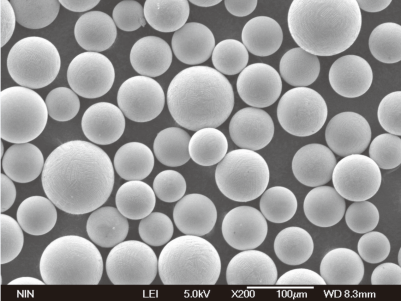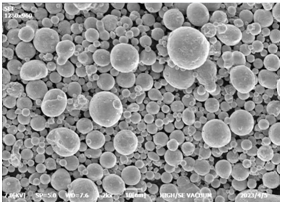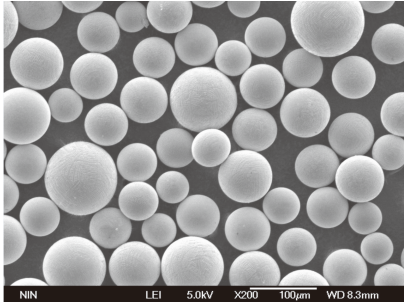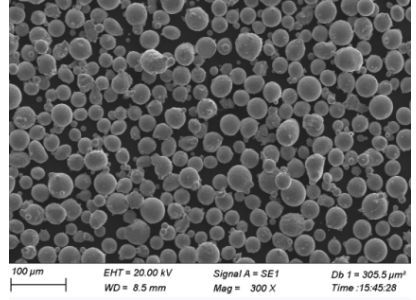Übersicht
Behandlung nach der Zerstäubung von Metallpulvern ist für die Herstellung einer Vielzahl von Industriezweigen, von der Luft- und Raumfahrt bis zu medizinischen Geräten, von entscheidender Bedeutung. Durch dieses Verfahren werden die Eigenschaften von Metallpulvern verbessert, so dass sie für bestimmte Anwendungen besser geeignet sind. Die Behandlung umfasst in der Regel Prozesse wie Glühen, Sieben und Oberflächenmodifizierung, um die Partikelgrößenverteilung, Morphologie und chemische Zusammensetzung zu verbessern.
Was ist eine Post-Atomisierungsbehandlung?
Die Nachzerstäubungsbehandlung bezieht sich auf die verschiedenen Verfahren, die bei Metallpulvern angewandt werden, nachdem sie durch Zerstäubung hergestellt worden sind. Bei der Zerstäubung wird geschmolzenes Metall in feine Tröpfchen zerlegt, die dann zu Pulverpartikeln erstarren. Die Behandlungen nach der Zerstäubung sind wichtig, um die Eigenschaften des Pulvers zu verbessern, seine Konsistenz zu gewährleisten und seine Leistung in der Endanwendung zu steigern.

Arten von Metallpulvern und ihre Zusammensetzung
Es gibt verschiedene Arten von Metallpulvern, die jeweils einzigartige Zusammensetzungen und Eigenschaften aufweisen, die auf bestimmte Anwendungen zugeschnitten sind. Im Folgenden werden einige der am häufigsten verwendeten Metallpulver und ihre Zusammensetzungen vorgestellt:
| Metall-Pulver | Zusammensetzung | Eigenschaften |
|---|---|---|
| Rostfreier Stahl 316L | Fe, Cr, Ni, Mo | Korrosionsbeständigkeit, hohe Zugfestigkeit |
| Titan Ti6Al4V | Ti, Al, V | Hohe Festigkeit im Verhältnis zum Gewicht, Korrosionsbeständigkeit |
| Aluminium 6061 | Al, Mg, Si | Leichtes Gewicht, gute mechanische Eigenschaften |
| Kobalt-Chrom-Legierung | Co, Cr, Mo | Hohe Verschleißfestigkeit, ausgezeichnete Biokompatibilität |
| Nickellegierung 625 | Ni, Cr, Mo, Nb | Hohe Festigkeit, ausgezeichnete Korrosionsbeständigkeit |
| Martensitaushärtender Stahl 18Ni300 | Fe, Ni, Co, Mo | Hohe Festigkeit, gute Zähigkeit |
| Kupferlegierung C18150 | Cu, Cr, Zr | Hohe Leitfähigkeit, hervorragende Verschleißfestigkeit |
| Wolframkarbid | WC, Co | Extreme Härte, Verschleißfestigkeit |
| Inconel 718 | Ni, Cr, Fe, Nb, Mo | Hohe Festigkeit, gute Oxidationsbeständigkeit |
| Bronze-Legierung CuSn12 | Cu, Sn | Gute Korrosionsbeständigkeit, ausgezeichnete Bearbeitbarkeit |
Merkmale des Pulvers für die Behandlung nach der Atmung
Nachzerstäubungsbehandlungen dienen dazu, verschiedene Eigenschaften von Metallpulvern zu verbessern. Hier ein Blick auf einige wichtige Eigenschaften:
| Charakteristisch | Beschreibung |
|---|---|
| Partikelgrößenverteilung | Sorgt für Gleichmäßigkeit und beeinflusst die Fließfähigkeit und Packungsdichte |
| Morphologie | Sphärische oder unregelmäßige Formen, die den Fluss und die Packung beeinträchtigen |
| Fläche | Beeinflusst Reaktivität und Sinterverhalten |
| Reinheit | Hohe Reinheitsgrade verringern das Kontaminationsrisiko |
| Fließfähigkeit | Beeinflusst die einfache Handhabung und Verarbeitung |
| Scheinbare Dichte | Auswirkungen auf die Packungs- und Sintereffizienz |
| Oxidationsstufen | Geringere Oxidation verbessert die Leistung bei Hochtemperaturanwendungen |
Anwendungen des Pulvers für Behandlung nach der Atombombenabgabe
Die verbesserten Eigenschaften von post-atomisierten Metallpulvern machen sie für eine Vielzahl von Anwendungen geeignet:
| Anmeldung | Beschreibung |
|---|---|
| Luft- und Raumfahrt | Hochfeste, leichte Komponenten |
| Automobilindustrie | Motorteile, Getriebeteile |
| Medizinische Geräte | Implantate, chirurgische Instrumente |
| Energiesektor | Turbinenschaufeln, Brennstoffzellen |
| Elektronik | Leitfähige Tinten, Wärmemanagement |
| Werkzeugbau | Schneidwerkzeuge, Matrizen |
| Additive Fertigung (3D-Druck) | Kundenspezifische, komplexe Geometrien, Prototyping |






Spezifikationen, Größen, Güteklassen und Normen
Bei der Auswahl von Metallpulvern für die Nachzerstäubungsbehandlung ist es wichtig, Spezifikationen, Größen, Qualitäten und Normen zu berücksichtigen. Hier ist eine detaillierte Tabelle als Referenz:
| Pulver Typ | Größenbereich (µm) | Klasse | Normen |
|---|---|---|---|
| Rostfreier Stahl 316L | 15-45, 45-105 | AISI 316L | ASTM A276, AMS 5653 |
| Titan Ti6Al4V | 15-45, 45-90 | Klasse 5 | ASTM B348, AMS 4928 |
| Aluminium 6061 | 20-63, 63-125 | AA 6061 | ASTM B209, AMS 4027 |
| Kobalt-Chrom-Legierung | 10-45, 45-90 | ASTM F75 | ISO 5832-4 |
| Nickellegierung 625 | 15-53, 53-150 | UNS N06625 | ASTM B446, AMS 5666 |
| Martensitaushärtender Stahl 18Ni300 | 10-45, 45-105 | Klasse 300 | AMS 6514, ASTM A538 |
| Kupferlegierung C18150 | 20-53, 53-150 | UNS C18150 | ASTM B606, RWMA Klasse 2 |
| Wolframkarbid | 5-15, 15-45 | ISO 9001 zertifiziert | ISO 9001, ASTM B777 |
| Inconel 718 | 15-45, 45-105 | UNS N07718 | ASTM B637, AMS 5662 |
| Bronze-Legierung CuSn12 | 20-63, 63-150 | UNS C90700 | ASTM B505, AMS 4880 |
Lieferanten und Preisangaben
Die Wahl des richtigen Lieferanten ist entscheidend für die Beschaffung hochwertiger Metallpulver. Im Folgenden finden Sie eine Übersicht über einige Lieferanten und ihre Preise:
| Anbieter | Standort | Metall-Pulver | Preis (USD/kg) |
|---|---|---|---|
| Hoganas AB | Schweden | Rostfreier Stahl 316L | $50 – $70 |
| LPW-Technologie | UK | Titan Ti6Al4V | $300 – $400 |
| Tischlertechnik | USA | Aluminium 6061 | $25 – $40 |
| Arcam AB (GE Additive) | Schweden | Kobalt-Chrom-Legierung | $250 – $350 |
| Sandvik | Schweden | Nickellegierung 625 | $100 – $150 |
| GKN Hoeganaes | USA | Martensitaushärtender Stahl 18Ni300 | $150 – $200 |
| AMETEK Spezialmetall | USA | Kupferlegierung C18150 | $30 – $50 |
| Kennametal | USA | Wolframkarbid | $70 – $90 |
| Metallpulver und Verfahren | USA | Inconel 718 | $200 – $250 |
| Herstellung von Metallpulvern | UK | Bronze-Legierung CuSn12 | $20 – $35 |
Vor- und Nachteile des Pulvers für die Behandlung nach der Atmung
Jedes Metallpulver hat seine eigenen Vorteile und Einschränkungen. Hier ist ein vergleichender Blick:
| Metall-Pulver | Vorteile | Beschränkungen |
|---|---|---|
| Rostfreier Stahl 316L | Korrosionsbeständig, hohe Festigkeit | Höhere Kosten im Vergleich zu anderen Stählen |
| Titan Ti6Al4V | Leichtes Gewicht, hohe Festigkeit | Teuer, schwierig zu verarbeiten |
| Aluminium 6061 | Leichtes Gewicht, gute mechanische Eigenschaften | Geringere Festigkeit im Vergleich zu Stahl |
| Kobalt-Chrom-Legierung | Hohe Verschleißfestigkeit, biokompatibel | Teuer, schwer zu bearbeiten |
| Nickellegierung 625 | Ausgezeichnete Korrosionsbeständigkeit, hohe Festigkeit | Teuer, hohe Dichte |
| Martensitaushärtender Stahl 18Ni300 | Hohe Festigkeit, gute Zähigkeit | Teuer, erfordert Wärmebehandlung |
| Kupferlegierung C18150 | Hohe Leitfähigkeit, Verschleißfestigkeit | Anfällig für Oxidation, geringere Festigkeit als Stahl |
| Wolframkarbid | Äußerst hart, verschleißfest | Spröde, teuer |
| Inconel 718 | Hohe Festigkeit, gute Oxidationsbeständigkeit | Teuer, schwierig zu bearbeiten |
| Bronze-Legierung CuSn12 | Gute Korrosionsbeständigkeit, maschinell bearbeitbar | Geringere Festigkeit im Vergleich zu anderen Legierungen |
Vorteile des Pulvers für die Behandlung nach der Atmung
Die Nachzerstäubungsbehandlung bietet zahlreiche Vorteile, die die Qualität und Leistung von Metallpulvern verbessern. Hier ein detaillierter Blick auf die Vorteile:
Verbesserte Partikelgrößenverteilung
Nach der Zerstäubung durchgeführte Behandlungen wie Siebung und Klassifizierung tragen zu einer gleichmäßigen Partikelgrößenverteilung bei, die für eine gleichbleibende Leistung bei Anwendungen wie der additiven Fertigung und der Pulvermetallurgie entscheidend ist.
Verbesserte Morphologie
Behandlungen wie Glühen und Wärmebehandlung können die Morphologie der Pulverpartikel verbessern und sie kugelförmiger machen. Kugelförmige Partikel fließen besser, lassen sich effizienter verpacken und führen zu höherwertigen Endprodukten.
Geringere Kontamination
Hochreine Pulver mit minimaler Verunreinigung sind für Anwendungen wie medizinische Geräte und Komponenten für die Luft- und Raumfahrt unerlässlich. Durch Nachzerstäubungsbehandlungen wird sichergestellt, dass die Pulver strenge Reinheitsanforderungen erfüllen.
Optimierte Fließfähigkeit
Eine gute Fließfähigkeit ist entscheidend für Verfahren wie 3D-Druck und Metallspritzguss.
Nachzerstäubungsbehandlungen verbessern die Fließeigenschaften von Pulvern und gewährleisten eine reibungslose und zuverlässige Verarbeitung.
Kontrollierte Oxidationsniveaus
Die Kontrolle des Oxidationsniveaus von Metallpulvern ist für Hochtemperaturanwendungen unerlässlich. Nachzerstäubungsbehandlungen tragen dazu bei, die Oxidation zu verringern und dadurch die Leistung und Lebensdauer der Endprodukte zu verbessern.
Spezifikationen, Größen, Güteklassen und Normen für Pulver für Behandlung nach der Atombombenabgabe
Bei der Auswahl des richtigen Metallpulvers müssen verschiedene Spezifikationen, Größen, Qualitäten und Normen berücksichtigt werden. Hier ist eine detaillierte Aufschlüsselung:
| Metall-Pulver | Größenbereich (µm) | Klasse | Normen |
|---|---|---|---|
| Rostfreier Stahl 316L | 15-45, 45-105 | AISI 316L | ASTM A276, AMS 5653 |
| Titan Ti6Al4V | 15-45, 45-90 | Klasse 5 | ASTM B348, AMS 4928 |
| Aluminium 6061 | 20-63, 63-125 | AA 6061 | ASTM B209, AMS 4027 |
| Kobalt-Chrom-Legierung | 10-45, 45-90 | ASTM F75 | ISO 5832-4 |
| Nickellegierung 625 | 15-53, 53-150 | UNS N06625 | ASTM B446, AMS 5666 |
| Martensitaushärtender Stahl 18Ni300 | 10-45, 45-105 | Klasse 300 | AMS 6514, ASTM A538 |
| Kupferlegierung C18150 | 20-53, 53-150 | UNS C18150 | ASTM B606, RWMA Klasse 2 |
| Wolframkarbid | 5-15, 15-45 | ISO 9001 zertifiziert | ISO 9001, ASTM B777 |
| Inconel 718 | 15-45, 45-105 | UNS N07718 | ASTM B637, AMS 5662 |
| Bronze-Legierung CuSn12 | 20-63, 63-150 | UNS C90700 | ASTM B505, AMS 4880 |
Vergleichende Analyse: Pulvertypen für die Behandlung nach der Atombombe
Lassen Sie uns einen detaillierten Vergleich der verschiedenen Metallpulver durchführen:
Edelstahl 316L vs. Titan Ti6Al4V
Rostfreier Stahl 316L ist bekannt für seine Korrosionsbeständigkeit und Festigkeit. Allerdings, Titan Ti6Al4V ist leichter und hat ein besseres Verhältnis von Festigkeit zu Gewicht, was es ideal für Anwendungen in der Luft- und Raumfahrt sowie in der Medizintechnik macht, wo das Gewicht ein kritischer Faktor ist.
Aluminium 6061 vs. Kobalt-Chrom-Legierung
Aluminium 6061 bietet gute mechanische Eigenschaften und ist leicht, aber es erreicht nicht die Verschleißfestigkeit und Biokompatibilität von Kobalt-Chrom-Legierungdas für medizinische Implantate und zahnmedizinische Anwendungen bevorzugt wird.
Nickellegierung 625 vs. Maraging-Stahl 18Ni300
Nickellegierung 625 eignet sich aufgrund seiner hervorragenden Oxidationsbeständigkeit hervorragend für Hochtemperatur- und korrosive Umgebungen. Auf der anderen Seite, Martensitaushärtender Stahl 18Ni300 bietet eine außergewöhnliche Festigkeit und Zähigkeit und eignet sich daher für den Werkzeugbau und strukturelle Anwendungen.
Kupferlegierung C18150 vs. Wolframkarbid
Kupferlegierung C18150 zeichnet sich durch elektrische Leitfähigkeit und Verschleißfestigkeit aus und eignet sich daher hervorragend für elektrische Kontakte. Im Gegensatz dazu, Wolframkarbid ist unvergleichlich hart und verschleißfest, ideal für Schneidwerkzeuge und Verschleißteile.
Inconel 718 vs. Bronzelegierung CuSn12
Inconel 718 wird wegen seiner hohen Festigkeit und guten Oxidationsbeständigkeit in extremen Umgebungen bevorzugt. Bronze-Legierung CuSn12mit seiner hervorragenden Bearbeitbarkeit und Korrosionsbeständigkeit wird häufig für Lager und Buchsen verwendet.
Expertenmeinungen und Studien
Studien und Expertenmeinungen unterstreichen die Bedeutung der Nachzerstäubungsbehandlung für die Erzielung der gewünschten Eigenschaften von Metallpulvern. Die Forschung zeigt, dass eine optimierte Partikelgrößenverteilung und Morphologie die Leistung von Pulvern in der additiven Fertigung und anderen Anwendungen erheblich beeinflussen.
So unterstreicht eine Studie der American Society for Testing and Materials (ASTM) die Rolle von Nachzerstäubungsbehandlungen bei der Verringerung der Porosität und der Verbesserung der mechanischen Eigenschaften von 3D-Druckteilen. In ähnlicher Weise betonen Experten der Metal Powder Industries Federation (MPIF) den Bedarf an hochreinen Pulvern für kritische Anwendungen wie Luft- und Raumfahrt und medizinische Geräte.

FAQs
| Frage | Antwort |
|---|---|
| Was ist eine Post-Atomisierungsbehandlung? | Die Nachbehandlung nach der Zerstäubung bezieht sich auf Verfahren wie Glühen, Sieben und Oberflächenmodifizierung, die nach der Zerstäubung auf Metallpulver angewendet werden, um deren Eigenschaften zu verbessern. |
| Warum ist die Partikelgrößenverteilung wichtig? | Die gleichmäßige Partikelgrößenverteilung sorgt für gleichbleibende Fließfähigkeit, Packungsdichte und Gesamtleistung bei verschiedenen Anwendungen wie 3D-Druck und Pulvermetallurgie. |
| Was sind die Vorteile der sphärischen Pulvermorphologie? | Kugelförmige Pulver fließen besser, lassen sich effizienter verpacken und führen im Vergleich zu unregelmäßig geformten Pulvern zu höherwertigen Endprodukten. |
| Wie wird die Kontamination durch die Nachzerstäubungsbehandlung verringert? | Behandlungen wie das Sieben und die Wärmebehandlung tragen dazu bei, Verunreinigungen und Schadstoffe zu entfernen, und gewährleisten hochreine Pulver, die für kritische Anwendungen geeignet sind. |
| Welches Metallpulver eignet sich am besten für Anwendungen in der Luft- und Raumfahrt? | Titan Ti6Al4V wird wegen seines guten Verhältnisses von Festigkeit zu Gewicht und seiner ausgezeichneten Korrosionsbeständigkeit bevorzugt und ist daher ideal für Bauteile in der Luft- und Raumfahrt. |
| Was sind die Hauptvorteile der Verwendung von Nickellegierung 625? | Die Nickellegierung 625 bietet hohe Festigkeit und ausgezeichnete Korrosionsbeständigkeit, insbesondere in Hochtemperatur- und korrosiven Umgebungen. |
| Wie wird die Fließfähigkeit von Metallpulvern verbessert? | Nach der Zerstäubung durchgeführte Behandlungen wie Sieben und Glühen verbessern die Fließeigenschaften von Pulvern, so dass sie leichter zu handhaben und zu verarbeiten sind. |
| Welche Bedeutung haben die Oxidationsstufen in Metallpulvern? | Niedrige Oxidationswerte sind für Hochtemperaturanwendungen von entscheidender Bedeutung, da sie die Leistung und Lebensdauer der Endprodukte verbessern. |
| Können Behandlungen nach der Atomisierung die mechanischen Eigenschaften verbessern? | Ja, Behandlungen wie Glühen und Wärmebehandlung können die mechanischen Eigenschaften von Metallpulvern verbessern, so dass sie für bestimmte Anwendungen besser geeignet sind. |
| Welches Metallpulver ist am besten für medizinische Implantate geeignet? | Die Kobalt-Chrom-Legierung wird aufgrund ihrer hohen Verschleißfestigkeit und ausgezeichneten Biokompatibilität häufig für medizinische Implantate verwendet. |

